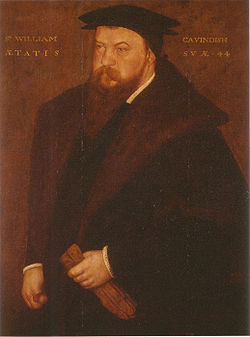William Cavendish (courtier)

Sir William Cavendish (c. 1505 – 25 October 1557) was an English courtier.[1] He was MP for Thirsk in 1547.[2]
Life
He was the younger son of Thomas Cavendish (died 1524), who was a senior financial official, the "clerk of the pipe", in the Court of Exchequer, and his wife, Alice Smith of Padbrook Hall.[1] He was the great-grandson of Sir John Cavendish from whom the Dukes of Devonshire and the Dukes of Newcastle inherited the family name of Cavendish.[1]
He became one of Thomas Cromwell's "visitors of the monasteries" when King Henry VIII annexed the property of the Catholic Church at the end of the 1530s, in the dissolution of the monasteries.[1] This followed from his successful career as a financial expert holding public office in the Exchequer, which led to his wealth.[1] He was accused of accumulating extra riches unfairly during the dissolution. After Cromwell's fall, he was sent to Ireland to survey and value lands which had fallen to the English during the Fitzgerald Rebellion.[1][3]

He was connected to the Seymour brothers Edward and Thomas, and via them to the family of Jane Grey, but he also took care to send tokens of goodwill to The Lady Mary. He was appointed Treasurer of the Chamber from 1546 to 1553 but, after an audit, was accused of embezzling a significant amount of money. Only his death saved the family from disgrace.
During the reign of Mary I, a favourable biography of Thomas Cardinal Wolsey was first published, written from the perspective of one of his closest aides, the one who had taken King Henry news of Wolsey's death. Although for centuries Sir William was said to be its author, historians now attribute it to his older brother George Cavendish (1494–1562) instead.[1]
Family
William Cavendish had a total of 16 children by three wives. His first wife was Margaret Bostock, she had five children, but only two daughters survived - Mary (died after 1547) and Ann who married Sir Henry Boynton in 1561. Margaret died in 1540. In 1542 he was married to Elizabeth Parker; she had three children, none of whom survived. She died after giving birth to a stillborn daughter in 1546.
In 1547 he married Bess of Hardwick.[4] He sold his property in Suffolk and moved to Bess's native county of Derbyshire. He purchased the Chatsworth estate in 1549 and the couple began to build Chatsworth House in 1552.[5]
In the ten years before he died, they had eight children, six of whom survived infancy; one of these, Elizabeth, later entered into a controversial marriage with the Earl of Lennox. Their daughter Frances Cavendish, married Henry Pierrepont. Another daughter, Mary Cavendish, married Gilbert Talbot, 7th Earl of Shrewsbury. Their daughter Alethea Talbot Howard is an ancestor of the 5th and later Dukes of Norfolk. Other of William and Bess's descendants became the Dukes of Devonshire and the Dukes of Newcastle. Their granddaughter Arabella Stuart was a claimant to the throne of England in 1603. William is also an ancestor of the late Queen Elizabeth, the Queen Mother and through her the modern British Royal Family.
He was succeeded by his eldest son Henry, who was a Knight of the Shire for Derbyshire for over 20 years.[1]
Notes
- ^ a b c d e f g h . Dictionary of National Biography. London: Smith, Elder & Co. 1885–1900.
- ^ http://www.historyofparliamentonline.org/volume/1509-1558/member/cavendish-sir-william-1505-57
- ^ Lovell, Mary S. (2005). Bess of Hardwick, First Lady of Chatsworth. Little, Brown. p. 43.
- ^ Pearson, John, The Serpent and the Stag, (Holt, Rinehart and Winston, 1983), 6.
- ^ Pearson, 18.
References
- Pearson, John, The Serpent and the Stag, Holt, Rinehart and Winston, 1983.
External links
- Chisholm, Hugh, ed. (1911). . Encyclopædia Britannica (11th ed.). Cambridge University Press.
